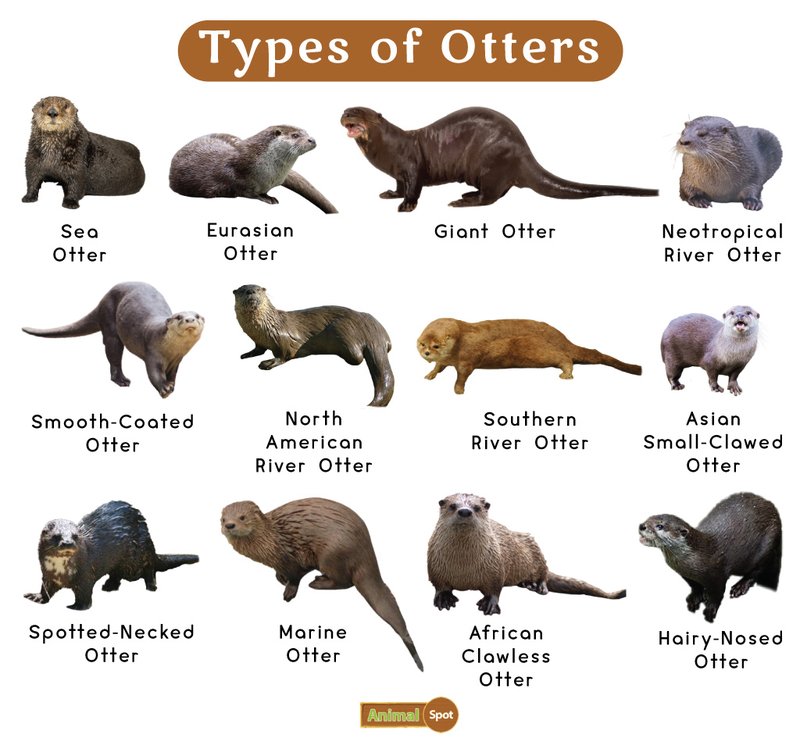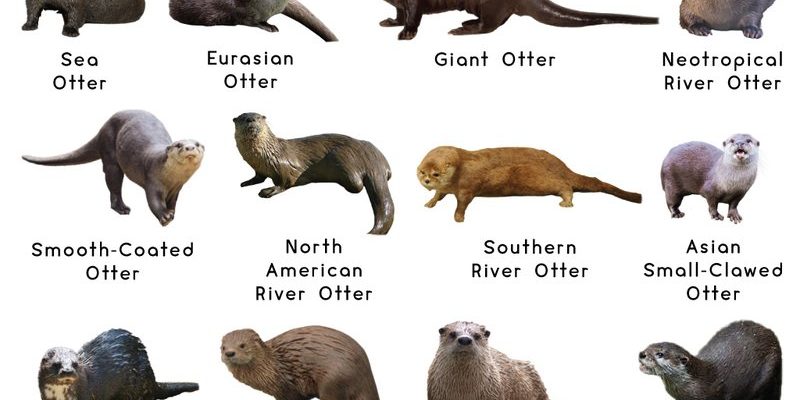
In this article, we’ll explore ten fascinating animals that remind us of the giant otter and discuss how to tell them apart. Think of it as a friendly guide for anyone looking to learn more about the animal kingdom. So grab your cup of coffee, sit back, and let’s dive in!
1. European Otter
The European otter is a close relative of the giant otter. Found mostly in rivers and lakes across Europe, this species is slightly smaller but shares many similar features. Their sleek, streamlined bodies make them incredible swimmers, just like their giant cousins. You might notice they have a darker, thicker fur that helps keep them warm in colder waters.
One key difference is size. The European otter typically weighs around 15 to 30 pounds, while a giant otter can weigh upwards of 70 pounds. Isn’t that surprising? Plus, while giant otters prefer more tropical settings, you’ll find European otters in a variety of climates, from the chilly Scottish Highlands to the serene lakes of Finland.
Behavioral Comparisons
Behaviorally, both otters are playful and social. However, while giant otters often work together in groups (called rafts) of 10 to 20, European otters are more solitary or found in small family groups. If you see a big gathering of otters in the water, chances are they’re not the European variety!
2. North American River Otter
The North American river otter is another delightful look-alike. Found all across Canada and the United States, these otters thrive in both freshwater and coastal areas. They have a similar body shape to the giant otter but are typically smaller, weighing around 50 pounds at most.
What sets them apart is their fur color and markings. North American river otters usually have a lighter, more varied coat, which can range from dark brown to gray. They also have a more playful demeanor, often seen sliding down mud or snowbanks into the water. Watching them is like seeing furry little kids enjoying the outdoors!
Habitat Preferences
While giant otters prefer the Amazon river basin, North American river otters are found in diverse habitats, including rivers, lakes, and even some coastal regions. If you spot one in a cold stream, there’s a good chance it’s a river otter, not a giant otter.
3. Sea Otter
If you’re thinking about otters, you can’t forget the sea otter. These adorable marine mammals are native to the coasts of the Pacific Ocean, from Alaska down to California. Sea otters are the smallest of the group we’ve discussed, weighing between 50 to 100 pounds. Their thick fur is designed to keep them warm in chilly waters, which is essential for survival in their environment.
What makes sea otters stand out is their unique method of using tools. They’re known for cracking open shellfish with rocks, a behavior that’s quite rare among mammals. So, if you see otters floating on their backs, using a rock on their belly, you’re definitely looking at sea otters!
Dietary Differences
While both sea otters and giant otters are carnivorous, their diets vary significantly. Giant otters prefer fish, crustaceans, and small mammals, while sea otters mainly feast on sea urchins, crabs, and clams. If you’re near the coast and see otters feasting in the water, chances are they’re sea otters.
4. Platypus
Now, you might be raising an eyebrow at this one! The platypus is quite different from the giant otter but shares a few interesting traits. Native to Australia, this egg-laying mammal has a duck bill, webbed feet, and a flat tail. It’s more of an oddball compared to other animals on this list.
Both the platypus and giant otters are semi-aquatic. They thrive in water but come onto land to rest. While giant otters are social, platypuses tend to be solitary and are mostly nocturnal. If you ever see a platypus swimming with its unique bill above water, you’ll definitely know it’s not a giant otter!
Adaptations
The platypus has some fascinating adaptations, like electroreception, which helps it hunt underwater. This ability allows it to detect electric fields generated by prey. In contrast, the giant otter relies on its excellent vision and social structure to hunt.
5. Capybara
Believe it or not, the capybara is another animal that often gets compared to the giant otter, especially in South America. While not an aquatic mammal like the others, capybaras are the largest rodents in the world and are commonly found near water sources.
Capybaras are social creatures, living in groups that can range from 10 to 20 individuals. They have similar habitats to giant otters, often seen munching on grasses or lounging by the water’s edge. However, the key difference lies in their appearance. While giant otters are sleek and agile, capybaras have a more robust, barrel-shaped body and can weigh up to 150 pounds.
Dietary Habits
Both animals are herbivorous, but their diets differ. Giant otters feast on fish and small animals, while capybaras primarily munch on grasses. If you’re by a river and see a large, furry creature grazing on the shore, it’s more likely a capybara than an otter!
6. Asian Small-Clawed Otter
The Asian small-clawed otter is the smallest otter species, with adults weighing around 11 pounds. These otters inhabit parts of Southeast Asia and are known for their playful behavior and short claws that make them unique. They have a more compact body compared to giant otters, which adds to their adorably chunky appearance.
Unlike giant otters, Asian small-clawed otters prefer to live in smaller groups and often hunt cooperatively in shallow waters. They are known to use their paws to search for food, which often includes small crabs and mollusks. If you see a tiny otter scurrying around a wetland, you’ll likely be looking at this species.
Social Structure
In terms of social behavior, Asian small-clawed otters are more similar to European otters than giant otters. They often groom each other and can be seen playing in the water as a family unit. However, unlike the giant otters’ large rafts, their groups tend to be smaller and more intimate.
7. Nutria
Also known as coypu, the nutria is a large rodent that looks a bit like an oversized rat but can be mistaken for a small otter at first glance. These creatures can be found in wetlands across the world but are especially abundant in the southern United States. They have a long, cylindrical body, and their fur is often a brownish color.
While nutria are not closely related to otters, their semi-aquatic lifestyle and habitat preferences can create confusion. If you see a large, furry animal swimming in a river, it might be a nutria, especially if it has a long tail and is munching on water plants.
Behavior and Diet
Nutria are herbivores, primarily feeding on aquatic plants and roots. This distinguishes them clearly from giant otters, which hunt fish and crustaceans. If you notice a rodent-like creature nibbling on plants near the water’s edge, it’s likely a nutria rather than an otter.
8. Beaver
The beaver is another creature you might think about when comparing to the giant otter. Known for their impressive dam-building skills, these animals are found in North America and Europe. Beavers are larger and more robust than giant otters, with flat tails and distinctive teeth for gnawing wood.
Beavers primarily live in freshwater environments and are strictly herbivorous, focusing on wood and aquatic plants. In contrast, giant otters primarily eat fish and are very social. So, if you observe a creature industriously building a dam, it’s definitely a beaver!
Building Skills
The beaver’s ability to modify its environment is unmatched. They are nature’s engineers, while giant otters focus on their social dynamics and hunting strategies. If you notice a significant construction project in the water, you can bet it’s the work of beavers!
9. Water Vole
Water voles are often confused with otters because they live in similar habitats, but they are quite small compared to the giant otter. Native to Europe and parts of Asia, water voles have a rounded, compact shape and are primarily herbivorous, feeding on grasses and reeds.
You might be surprised to hear that water voles are also excellent swimmers. They have webbed feet that help them navigate through water. However, they lack the playful social nature of giant otters and are usually more solitary.
Habitat and Role
Water voles play a vital role in their ecosystems by helping to maintain vegetation levels near water bodies. If you see a small, furry creature swimming alone or munching on reeds, it’s likely a water vole, not a giant otter.
10. Lesser Panda
The lesser panda, or red panda, may seem like an oddball choice. However, they inhabit similar forested areas and are also known for their unique features. Lesser pandas are tree-dwelling mammals native to the Himalayas and southwestern China. They have round faces, red fur, and bushy tails.
While they are not aquatic, you might find them in cooler, moist environments, often compared to the habitats of giant otters. Unlike the giant otter’s playful demeanor, lesser pandas are often more reserved and spend their time climbing trees and munching on bamboo.
Physical Differences
At first glance, it’s easy to see why someone might mix them up due to their furry appearance. Still, lesser pandas are much smaller, weighing only about 8 to 14 pounds. If you ever see a small furry creature high up in a tree, munching on leaves, you’re likely looking at a lesser panda.
So there you have it—ten animals that share similarities with the giant otter, each unique in their own right. From the playful behaviors of river otters to the robust nature of beavers, these animals illustrate the diversity of life found in aquatic and semi-aquatic environments. Understanding how to tell these creatures apart can deepen your appreciation for wildlife.
Next time you’re by a river or lake, keep an eye out for these fascinating animals. Each one, in its own way, contributes to the rich tapestry of our ecosystems. Whether you’re an aspiring wildlife enthusiast or just curious, there’s always something new to discover about our animal friends!

